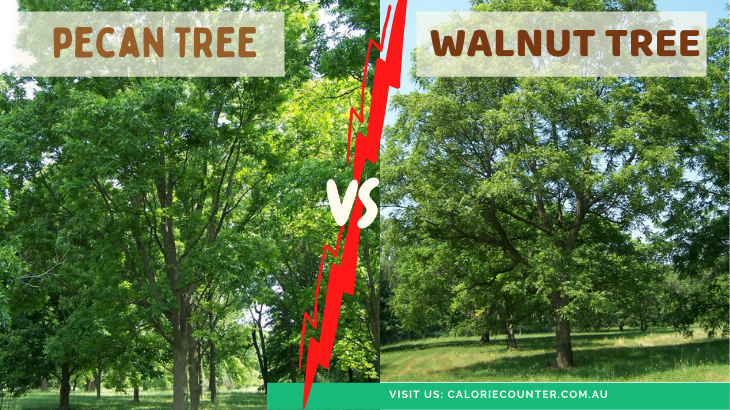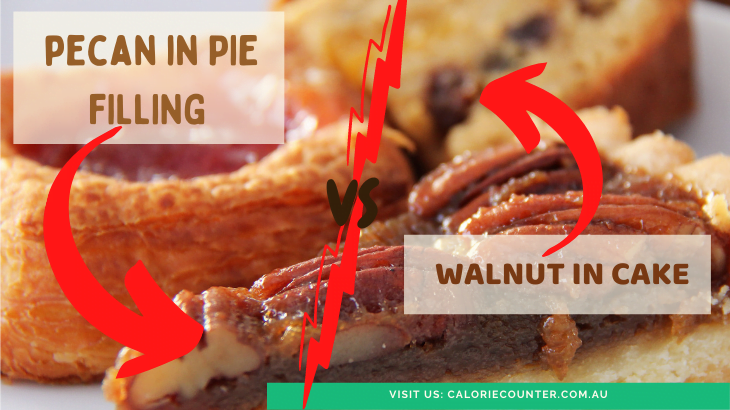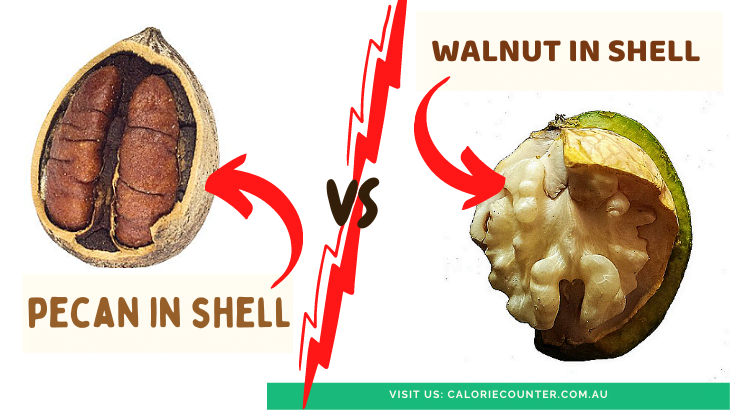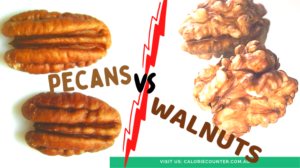Pecan versus walnut, which to choose? Pecans and Walnuts are from the same Hickory fruit family and thus often mistaken for each other. Pecans are more popular, probably because they are generally cheaper, sweeter, and smaller. In some ways walnuts are more nutritious, but they’re bitterer and less versatile. Here’s how these two nuts compare in calories, nutrients, taste, and origin:

Pecan VS Walnut Taste
Pecans have a rich, creamy flavour whilst walnuts taste fruity, with a bitter edge. Both are usually cooked (toasted or roasted) before sale to reduce bitterness, kill fungus, and enhance their natural nutty flavours. The milder taste of pecans makes them ideal for sweet desserts, whilst walnuts do better in muesli and savoury dishes. Both walnuts and pecans taste less bitter when their brown skin is removed. A recent poll in Box Hill North, Melbourne found that most people prefer the taste of pecans over walnuts.
Pecan VS Walnut Nutrition and Calories
Pecans and walnuts have a similar amount of calories. Depending on the way each has been processed, any given batch of walnuts might have a higher calorie count than an equivalent batch of pecans, and vice-versa. The difference depends on water content (the drier the nut, the more calories by weight it has). For the most popular types of walnut and pecan sold in Australia, pecans have 712 calories (2980kJ) per 100g, whilst walnuts have 717 calories (3000kJ).
Of course, being nuts (or more correctly nut-like stone fruit seeds), both walnuts and pecans are high calorie foods. You can read about why that is so here, in our post about cashew nuts. In a nutshell, they contain lots of oil/fat.
Protein is the Difference
Walnuts have 50% more protein than pecans (15g/100g compared to 10g/100g). Pecans on the other hand have less saturated fat (5g/100g) than walnuts (7g/100g). Both walnuts and pecans contain a massive 72 grams of fat in total per 100 grams. Pecans have more sugar (4g compared to 2g), perhaps explaining why they are sweeter.
Micronutrient Dense
Both Pecans and walnuts are packed with micronutrients, especially B vitamins and magnesium, zinc, copper, phosphorous, and iron. Walnuts tend to have more than twice the folate and Vitamin B6 than pecans, whilst the reverse is true in the case of Vitamin A and E. In either case, 100 grams covers just about the entire daily recommended dosage of B vitamins and magnesium, copper, and zinc.
They both also contain phytochemicals like polyphenols which may have health benefits like cancer prevention. It is a good idea to include phytochemical-rich foods in the diet, in moderation. Whilst there are many benefits to eating them, too-high concentrations of specific compounds may interfere with hormonal balance.

Pecan VS Walnut Colour and Appearance
Whole walnuts are generally bigger than pecans. They’re also rounder, paler, and shaped more like a brain. Overall, walnuts appear wilder, with fractal protuberances on the surface. Pecans have a distinct straight ridge running down their middle. Even though they look quite different in raw form, pecans and walnuts are often confused for each other when chopped up in a salad or baked in a pastry. When shelled, both have a bumpy surface covered in a smooth, thin brown skin which can be peeled off. Pecan skins are usually of a darker hue than walnuts.

Pecan VS Walnut Tree
Pecans and walnuts are the inner parts of the seed of different varieties of Hickory fruits. This means that neither walnuts nor pecans are true botanical nuts, even though some experts choose to disagree. To the layperson, pecan and walnut Hickory trees are virtually identical until they start producing fruit. Both grow to a height of about 40 metres and lose their leaves in autumn.
Technically, both walnut and pecan husks develop from the bracts and bracteoles, but walnut husks also grow from the sepals, or sometimes the sepals only. Enough to say that you’d have to be a botanist to figure out the exact differences between the two trees.

Pecans VS Walnuts in Baking
Given their similar origin, fat and water content, and nutritional profile, it is perfectly safe to substitute pecans for walnuts and vice versa in any recipe. Walnuts, being less sweet, may require slightly more sweetener. Their higher protein content may make for a chewier bake than a pecan variant. Walnuts are also bitterer, hence the vastly greater popularity of pecan in baked goods compared to walnut pie. Walnuts tend to be folded into breads or dispersed throughout cake or muffin batter, rather than concentrated in pie filling or tart topping in the the way pecans are.

Conclusion
The choice between pecans and walnuts comes down to two things: personal taste and protein. If you are keen to get as much protein as you can from the nut component of your diet, choose walnuts. Otherwise, choose whichever tickles your tastebuds more. Either way, you will be eating a high-calorie, nutritious, Hickory fruit seed packed with vitamins, minerals, and phytochemicals.









